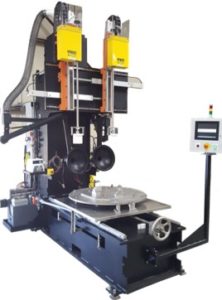With a name like blowout preventer (BOP), there is no guessing as to the critical nature of the component. A BOP is used to seal, control and monitor oil and gas wells to prevent the uncontrolled release of crude oil and/or natural gas. So, when one of the leading specialty manufacturers and suppliers of pressure control equipment approached us to apply a corrosion protection deposit to the seal pockets of their BOP, deposit quality and adhesion were main concerns.
The manufacturer required 0.030” – 0.060” of nickel for repair and to prevent any corrosion damage inside the critical seal pockets of the BOPs. Each BOP contained up to 8 seal pockets and desired turnaround time was 4-6 parts every 4-6 weeks. But the quantity and turn time were not the only challenges for this application.
The simplest approach to plating the off center seal pockets was to orient them horizontally and use an ID plater to rotate the anodes. Unfortunately, plating horizontally required flipping the part 180 degrees to prevent uneven thickness distribution and added a significant amount of time and part handling to the operation.
To improve this situation, technicians oriented the part (seal pockets) and ID plater vertically which reduced the handling of the part and provided an even plating thickness.
While this method worked to effectively plate the parts successfully, the ID plater setup required extensive masking. Further, precisely aligning the anodes with the seal pockets was difficult and time consuming. If the technician were to misalign the anode, the plating distribution would be uneven as well as causing excessive wear and plating in the cover.
But, the experts at SIFCO ASC approached the manufacturer with a state-of-the-art solution, a semi-automated machine built to increase throughput and reduce changeover time. The vertical ID plating machine uses automated PLC controlled servos and digital position readout for accurate anode alignment every time. And to cut down even further on the labor time, special masking fixtures were developed.
Now, once the BOP is in place, the technician will carry out the preparatory procedures using hand-held tools. Then, with the push of a button on an HMI, the plating process begins. The anodes will automatically align with the bores and with rectifier software controls, the technician doesn’t have to worry about setting the amps and volts during the procedure. This ensures a consistent deposit every time for every pocket. And with a carbon filter ventilation built right in, the machine can be place anywhere on the shop floor.
Other benefits of the automating the plating operation have also been realized, including increased throughput by plating two areas at the same time, improved productivity by decreasing setup and masking time, reduced labor costs, process control and consistency, optimized deposit properties with standardized plating processes, data logging, and reduced lead time – from 25 days per part to 8!
Through the ingenuity of the SIFCO ASC team and the willingness of the manufacturer, meeting the requirement of 4-6 parts every 4-6 weeks has not only been met, but has been surpassed with superior quality and consistency.

 Chinese (Simplified)
Chinese (Simplified)  English (UK)
English (UK)  French
French  German
German  Spanish
Spanish  Swedish
Swedish 



